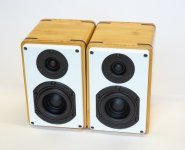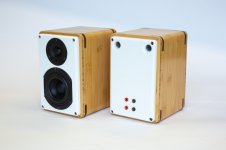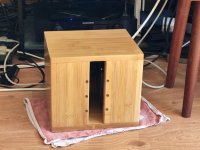We built a pair of mini speakers for a young student at university.
The idea came from here :
https://projectgallery.parts-express.com/speaker-projects/sls-85/
https://audioxpress.com/article/Test-Bench-Tymphany-Peerless-SLS-85S25CP-04-04-3-5-Woofer
But with a different enclosure made from bamboo ply's from IKEA, with front and rear from white Corian.
The drivers are available at Digikey, which makes ordering real easy.
Patrick
.
The idea came from here :
https://projectgallery.parts-express.com/speaker-projects/sls-85/
https://audioxpress.com/article/Test-Bench-Tymphany-Peerless-SLS-85S25CP-04-04-3-5-Woofer
But with a different enclosure made from bamboo ply's from IKEA, with front and rear from white Corian.
The drivers are available at Digikey, which makes ordering real easy.
Patrick
.
Attachments
Last edited:
Some details as requested.
Inside cross section is 170x100 mm.
16 mm bamboo ply.
Depth to match design volume.
Reflex pipe is dual 16mm ID X 100mm long in perspex.
Cross over is shamelessly copied from the link in post 1.
Patrick
.
Inside cross section is 170x100 mm.
16 mm bamboo ply.
Depth to match design volume.
Reflex pipe is dual 16mm ID X 100mm long in perspex.
Cross over is shamelessly copied from the link in post 1.
Patrick
.
Attachments
Very nice little speakers!
Who ever would like to build them, be quick to get the drivers - there is only the remaining stock available (still 325 woofers and 316 tweeters there).
as a side note: I was just about to order peerless 830657 drivers from toutlehautparleur yesterday and suddently there was only 1 remaining - someone must have bought the whole stock except one!
by the way such a speaker would be an ideal application for a flared port, calculated with my NFR=0,5 calculator excel sheet!
with the existing narrow 1,6 cm tubes there will be very strong chuffing and compression already at 2,83 V input:
port speed is ok with 17 m/s (5% of c)
strouhal number at resonance frequency 0,27 (should remain above 1,5). that creates strong turbulence at port exit, leading to compression and chuffing.
Using the flared port calculation mentioned above it's still not easy to find the right compromise for maximum SPL and useful port size.
A sensible compromise could be:
Dext = 5 cm
L act = r fit = 11 cm
r round = about 0,5 cm

resulting in a resonance frequency 70,9 Hz
strouhal number at very safe 2.4 and maximum airspeed in the middle port section 21 m/s, still OK for input voltage 2,83 V.
For maximum output capabilites the geometry should follow a slightly more "straight" tube, with NFR (normalized flare rate) around 0,35 - that would translate into a wall curvature radius:
r fit = L act / (2 * NFR) = L act * 1,43
that would lead to a bigger middle section diameter, reducing the corresponding airspeed, but still keeping the port short (or rather as short as possible).
It's clear why loudspeakers of similar dimensions often use passive radiators instead of vents!
Who ever would like to build them, be quick to get the drivers - there is only the remaining stock available (still 325 woofers and 316 tweeters there).
as a side note: I was just about to order peerless 830657 drivers from toutlehautparleur yesterday and suddently there was only 1 remaining - someone must have bought the whole stock except one!
by the way such a speaker would be an ideal application for a flared port, calculated with my NFR=0,5 calculator excel sheet!
with the existing narrow 1,6 cm tubes there will be very strong chuffing and compression already at 2,83 V input:
port speed is ok with 17 m/s (5% of c)
strouhal number at resonance frequency 0,27 (should remain above 1,5). that creates strong turbulence at port exit, leading to compression and chuffing.
Using the flared port calculation mentioned above it's still not easy to find the right compromise for maximum SPL and useful port size.
A sensible compromise could be:
Dext = 5 cm
L act = r fit = 11 cm
r round = about 0,5 cm
resulting in a resonance frequency 70,9 Hz
strouhal number at very safe 2.4 and maximum airspeed in the middle port section 21 m/s, still OK for input voltage 2,83 V.
For maximum output capabilites the geometry should follow a slightly more "straight" tube, with NFR (normalized flare rate) around 0,35 - that would translate into a wall curvature radius:
r fit = L act / (2 * NFR) = L act * 1,43
that would lead to a bigger middle section diameter, reducing the corresponding airspeed, but still keeping the port short (or rather as short as possible).
It's clear why loudspeakers of similar dimensions often use passive radiators instead of vents!
Now with matching subwoofer. 😊
https://www.diyaudio.com/community/threads/really-tiny-ripole.411923/post-7665530
Patrick
.
https://www.diyaudio.com/community/threads/really-tiny-ripole.411923/post-7665530
Patrick
.



